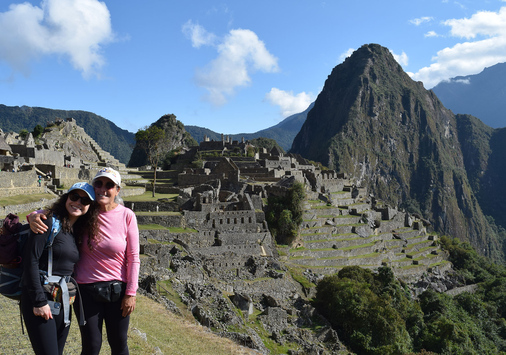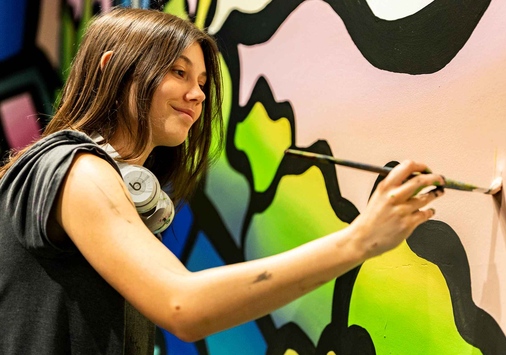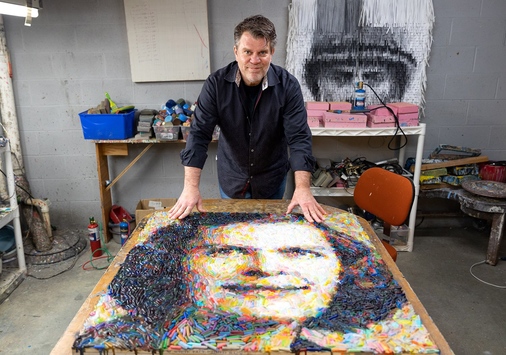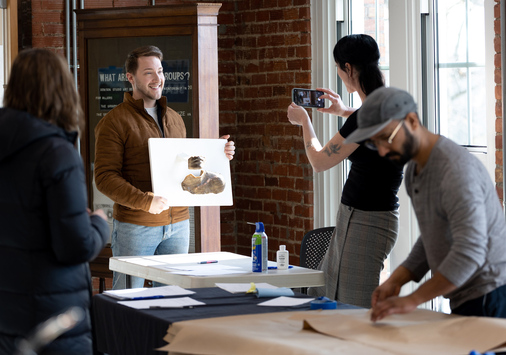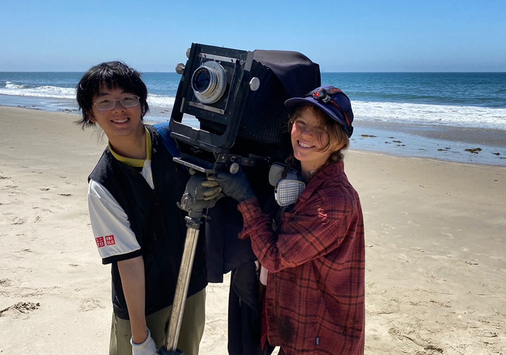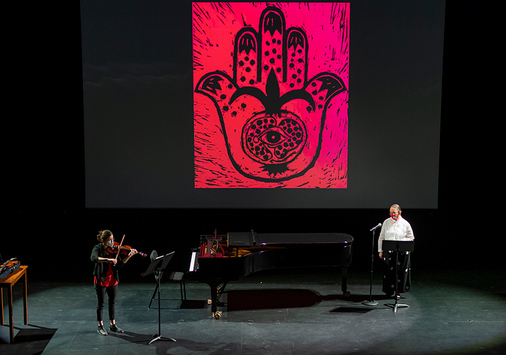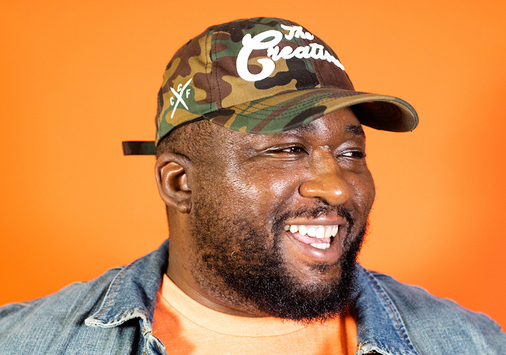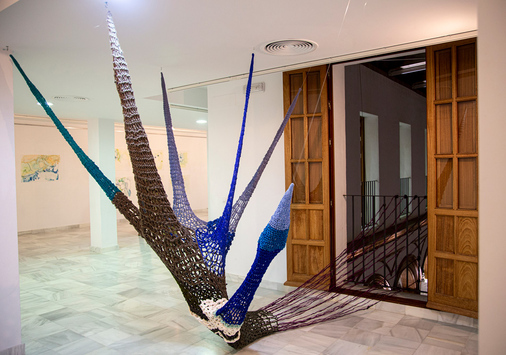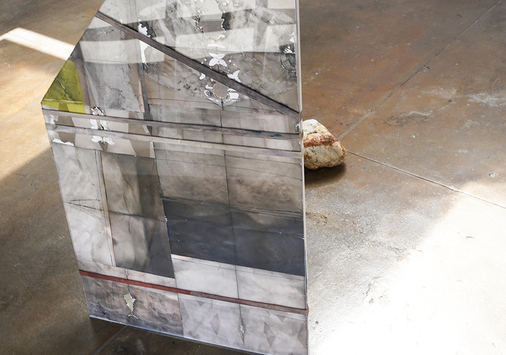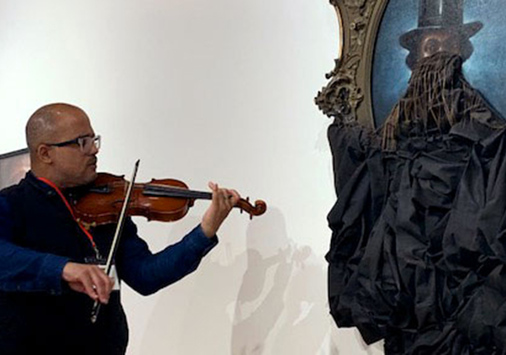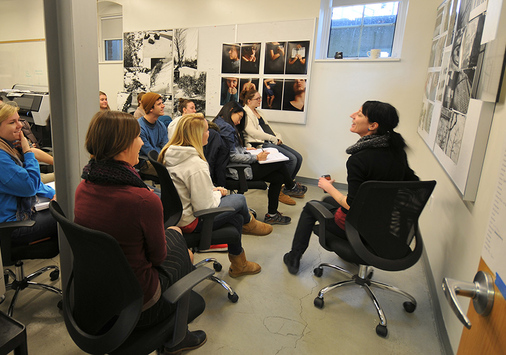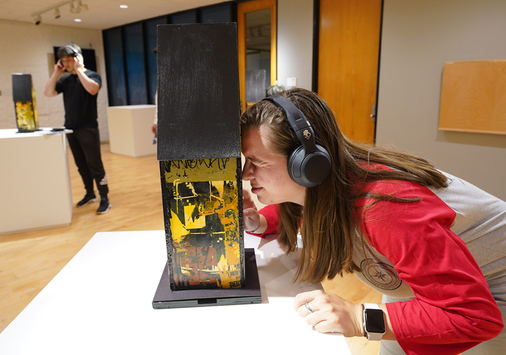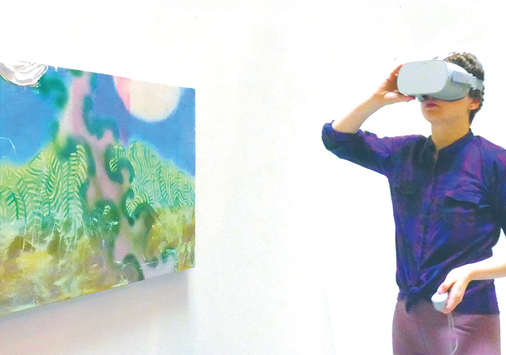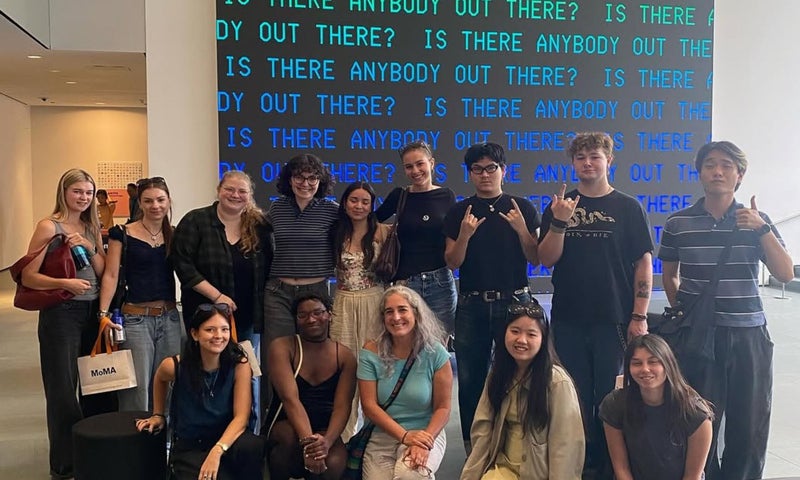Courses
2025 - 2026
For this academic year's course catalog, please visit our Academic Catalog site. For courses currently offered, please refer to the Schedule of Classes.
All majors must complete an arts and design-related internship or arts experience, to be approved by the Visual Arts Department Chair.
For BFA degree completion in Visual Arts, students present a solo exhibition showcasing a cohesive body of work, submit a written thesis that explores their artistic practice, influences, and conceptual themes, and participate in an oral defense where they present their work and respond to questions from faculty, demonstrating their ability to critically engage with their art.
BA and BFA Visual Art majors complete their degree by participating in a group exhibition and gallery talk about their artistic practice, influences, and conceptual themes.
Students will investigate modes of creative research and methodologies of art and design to inform and expand their understanding of visual vocabulary and expression. Using process as a through line through this course, students will investigate materials and concepts, examining how these can be applied in both art and design contexts. In each section of the course, students will be introduced to material(s) that they will then translate and change, shifting between 2D and 3D—ultimately allowing one project outcome to become the source material for the next. Traditional ideas of a final product will be questioned through the students’ engagement with processes that are constantly being asked to change into different dimensionality, modes of representation, or expression. Students will follow a trajectory of acquiring a basic vocabulary integral to art and design practices—that of form, color, composition, and material capacities—and then applying it as they move from one project to the next. This class will use demonstrations, readings, discussions, projects, critiques, and in-class workshops to explore materials and ideas and how they interact with each other. We are interested in students being engaged in the question of process as they learn the techniques and ideas that will guide them in seeing and doing, making, and meaning through the visual arts. The exploration of technique and process will be augmented by discussions of relevant contemporary artists related to each module. Students will have the opportunity to research artists and share their work, sharpening their ability to speak critically about art and design.
Animation is the illusion of motion created by the consecutive display of slightly varying drawings or models of static elements. In this course, students we learn the fundamentals of traditional animation techniques, as well as cover many aspects of the more experimental contemporary forms of stop-motion animation processes. Students will be given several animation "studies" over the course of the semester that will offer them experience with different types of stop-motion and computer key-framed techniques, as well as experience in story-boarding, sound recording, character movement and rig development, and post digital effects work. In addition to workshop projects, students will be exposed to outside readings and film viewings.
A studio course in the fundamentals of drawing in several media. Problems in still life, rendering, and perspective will be covered, along with historical and contemporary approaches to drawing.
Historical and contemporary approaches to painting technique will be covered in readings and discussions and by working with painting materials.
The emphasis of this introductory photography course is to give students a foundational background in the technical and conceptual underpinnings of photography. Students will be exposed to a wide variety of technical and aesthetic concerns involved in making photographs, including: aperture, shutter speed, depth of field, film-less photography, principles of darkroom image creation, composition, camera handling, selecting digital file formats, Lightroom CC, Adobe Photoshop and printing to the Epson printers. Equal to the acquisition of skills, and familiarity with digital SLR camera use, the goal is to enable students to see the photographic world all around us with criticality, and a sense of empowerment that allows students to both critique and respond to the world through photographs.
A broad introduction to all ceramics potential. Clay working in sculptural as well as vessel-oriented directions. Slide presentations and discussions with references made to ceramic history as well as to contemporary ceramic art. Students are introduced to a variety of hand building techniques and are encouraged to pursue their individual creative potential.
An introduction to producing Ceramic forms, both utilitarian and sculptural, using the potter's wheel. Image presentations and discussions will introduce students to the contemporary and historical role of ceramics in art and material culture. Students are introduced to a variety of throwing techniques and surface treatments and are encouraged to pursue their individual creative potential.
As a foundation course, emphasis will be on historical and contemporary concepts in art through the media of printmaking. The course will provide exposure to printmaking processes with direct involvement in one of the following: intaglio, screen printing and relief. Tools, materials and techniques will be fully covered regarding the featured printmaking process. Art issues such as format and content of visual images will be stressed as well as technical procedures for implementing the print.
This course is an introductory course into sculpture. It will concentrate on developing sculptural thinking and working habits, the safe use of basic tools, understanding ways of seeing and the translation of experience into an arts practice.
This course introduces students to the essential strategies and techniques for designing and building wooden objects, emphasizing problem-solving and hands-on experience. You will learn to use Fusion 360, a powerful 3D modeling tool, to plan and visualize your projects, helping you consider the construction process before moving to the woodshop. Designed for all skill levels, the course covers working with plywood, softwood, hardwood, and cardboard. You'll gain proficiency in using hand and power tools safely. The first half focuses on tool mastery, and the second half allows you to customize techniques for your individual projects. Through collaborative assignments, discussions, and readings, you'll explore the historical and theoretical contexts of Art, Design, and Craft. Safety, community, and active participation are crucial for success in this course, fostering a supportive environment where every student can thrive.
With a mix of traditional printmaking processes and digital technologies, students in this class will create a range of thematic handmade books as singular works of art and/or self-published editioned printed matter. In class demonstrations will include a variety of processes ranging from designing, printing, binding and publishing. Students will study the history of not only bookmaking but zines & DIY culture in the context of larger societal issues and contemporary artistic practices. Simple research projects, presentations and visiting artist/publisher talks will complement the primary studio focus of the class. The innovative history of printed matter, small press publishing, artist networks and collectives will be included in this overview. Along with community centered projects, class creative work will subvert expectations of traditional publishing to lead both introductory and advanced art students to make intimate artist books and zines that are topical, personal and interactive.
Situated in the traditions of printmaking and printed matter, this studio art course introduces students to the elements of visual communication, storytelling and concepts of art-making that are the fundamentals of illustration. Looking to the grand history of pictorial illustration in a variety of literary forms (short stories, novels, nonfiction prose, children’s’ books) and media (film, music), sequential assignments are structured to not only develop each student’s individual artistic goals but also offer insight into issues facing today’s contemporary illustrators. The class will examine the ways that stories are told that combine words and pictures, as well as an extended focus on illustration practices that include the collection of research materials, seeing problem solving from multiple perspectives and creative brainstorming on ideas. Technical Printmaking Processes for the class include collage, woodcut (hand crafted and digital Laser cut techniques), Linoleum, screen printing and mixed media processes.
Drawing helps us see! Students will make keen observations and interpretations of the landscape through the immediacy and directness of drawing. This course introduces illustrative methods in a variety of media to render our visual world accurately. Still, it will also include explorative and experimental mark-making methods to reveal what we cannot see. We will study a wide range of visual artists who use drawing to tackle the environment as subject matter, inspiration, and even as material. Art projects will occur in the studio and outside. Hands-on art activities about the landscape will be supplemented with various course readings, discussions, and presentations to contextualize an art practice to the broader world.
This course introduces students to the genre of landscape painting. Art making will be completed in the studio and out in the field. Art projects are devised to have students develop acute observations about the landscape while creating newfound relationships with it. Technical demonstrations in paint application and design are coupled with strategies of research and preparation to produce thoughtful and critical pictorial representations. An introduction to the historical lineage of the painted landscape will be balanced with exposure to contemporary artists and concepts. Students will use painting as an excuse to probe their landscape, to dissect and invert it, to wander off the path, and to redefine where it starts and ends. Group readings, presentations, and discussions complement the studio workshop environment by helping to contextualize an art practice to the broader world.
Crosslisting: SES 211.
Through a series of drawing and printmaking projects, this course seeks to explore and creatively express queer culture, aesthetics, and GLBT art history, as well as notions of identity, gender, orientation, and sexuality. Art students will employ traditions of journalistic comics, collage, screen-printing, photo-copies, community collaborative artistic work (zines), and research presentation projects to not only celebrate queer artistic practices but also reveal the often damaging impact society and politics has on self-identity and expression.
Crosslisting: QS 213.
Continued painting experience with emphasis on developing individual concepts.
Prerequisite(s): ARTS 115 or consent.
This is an upper-level photography course that asks students to consider the photograph as a disruptive force with potential energy for re-imagining the relationship to self, history, document, and time. Using a specifically BIPOC (Black Indigenous People of Color), feminist, and queer representation of artists and theorists, students will be asked to critically engage with the issues and possibilities of non-dominant stories and documents. Students will be encouraged and supported to find their own empowered, creative, and critical voice to speak back to traditionally white hetero-patriarchal power. Students will use digital cameras (DSLRs) to capture both still images and video. Students will further their knowledge of Lightroom, Photoshop, and learn the basics of Adobe Premiere.
Prerequisite(s): ARTS 117.
Crosslisting: QS 217 and WGST 217.
Intermediate level photography course for students interested in learning how to use film cameras (both 35 mm and medium format) including shooting, developing and printing black and white film in the wet darkroom. This is a studio art course that focuses on techniques of early photography that are tied to a material process using film and darkroom processing. When you leave the course you will understand; analog cameras, film development, darkroom printing, scanning negatives and printing digitally from negatives. You will have been asked to respond to readings that will give you a deeper understanding of the historical and contemporary implications of the medium. You will have made work in response to assignments using your voice, as expressed through photography. You will have been asked to see slowly -- and then observed what it is that you have seen.
Prerequisite(s): ARTS 117 or consent of instructor.
In this intermediate level class students will gain a greater understanding of the range of possibilities their cameras offer in different lighting situations, as well as become thoughtful and empowered creators of images through manipulating studio and off camera light to achieve individual goals. One of the primary goals of this class is to use studio strobe lighting, tungsten lighting, strobist kits and portable strobe lights in technical and conceptual.
Students will hone the skills gained in previous ceramic courses and will focus on refining the application of learned techniques to produce visually and conceptually compelling work. Image presentations and discussions will lead to a deeper understanding of contemporary and historical ceramic art. Students will gain experience in different firing technologies and clay and glaze chemistry. Primary emphasis is on students' individual conceptual and technical development.
Prerequisite(s): ARTS 121, ARTS 122 or Ceramic Multiples.
This course will examine the relationship of words and pictures through the study and making of autobiographical and nonfiction comics. As other Studio Art courses examine the disciplines of photography, ceramics, sculpture, or painting through experiential learning, so too will students realize the potential of this discipline to reveal their creative selves through its unique visual language. Placing practice in context, comics history will be explored with the emphasis on contemporary cartoonists and graphic novelists as artists focused on relevant first-person narrative storytelling and comics journalism. Traditional techniques of layout, design, and storyboarding will be included along with drawing and writing exercises. Course projects will extend technical exercises to address content concerns through in-class workshops, presentations on cartoonists, critiques, field trips, and a range of short and long outside projects that will gradually build to more ambitious creative comic undertakings by the semester's end. No previous studio or visual arts or drawing experience is required.
In this studio course students will explore the numerous options for surface expression in ceramic art making. One of clay's unique properties is the ability to faithfully record impressions in its surface - from the fingerprint of a potter to patterned designs stamped into the surface. Today, mark making on clay has caught up with technology, incorporating digital processes into the roster of print technique possibilities. Students will learn to make their own glazes, effectively use slips, glazes, china paints, lustres, print-transfers, photo-decals and alternative firing techniques. Students will explore the relationships between content, form and surface through the creative process, group critiques, readings, image presentations and discussions.
Prerequisite(s): A Denison University ceramic course or consent of instructor.
In this studio course students learn to create ceramic objects using plaster molds, how to make casting slip, and the basics of kiln firing. We will explore the relationship between Art, Design, and Craft, and students will be encouraged to push the boundaries of where these categories begin and end. Producing ceramic objects from molds allows for greater refinement of the object, unlimited possibilities of form, and the potential of creating multiple replicas or variations on one form. Because of inherent associations with industry, technology, and mass production, objects produced from molds offer unique conceptual possibilities that students will pursue through the creative process, group critiques, readings, and discussions.
Prerequisite(s): Any Denison University Studio Art course or Visual Arts course or consent of the instructor.
Animation is the illusion of motion created by the consecutive display of slightly varying static elements. In this course, students will learn the fundamentals of stop-motion animation techniques as well as explore many aspects of the other more contemporary forms of stop-motion animation processes used by today's animators. This course is focused primarily on the Stop-Motion animated short. Students will learn all aspects of this genre, from the initial development of an idea to the execution and completion of a fully realized animation. Students will be given several assignments over the course of the semester which will give them experience with different types of stop-motion animation styles. These assignments will also give students direct experience with story- boarding, framing and cutting shots, character movement analysis, background audio and Foley (sound effects), and some post digital effects work.
Students may work with any printmaking processes in which they have had experience or with the consent of instructor. Processes available to Printmaking II students include: relief, lithography, intaglio or screen printing. Emphasis will be on continued technical and conceptual development.
Prerequisite(s): ARTS 131 or consent.
In installation art the space is considered like the blank sheet of paper of a drawing. Its goal is the transformation of spaces through the use of objects, images, color, etc. Site-specific art is art that is created in a certain space, where the place is part of the work and adds meaning to it. This Installation/Site-Specific class will focus on creating objects that will transform a variety of architectural spaces.
Combining theory and practice in the sculpture studio, this topical intermediate sculpture course focuses its central objective around an overarching relevant interdisciplinary theme that varies per semester. Along with theoretical readings and presentations, a series of sculpture projects will be developed by each student to explore the selected research theme created with a range of techniques and materials. Course materials may include plaster, wax, fabric, found objects, wood, and metal. The works will acquire meaning based not only on the form, but also on the material the work is made out of and its connotations. Importance will be given to the investigation on the theme, to the process of sculptural creation and to the end products, the final sculpture.
This studio art course is an introduction to the basic expressive potential to create two- and three-dimensional works. The use of natural and/or artificial materials will be introduced and a combination between structural and non-structural materials, to make the composition work as an image, object or installation. The artworks created will be the result of an analytic process guided by information acquired, the interpretation of that information and experiences lived by each participant of this class.
This studio art course will focus on processes of creating and executing actions that may have an artistic content. In this course the participants will generate actions that will be performed. Prior to the execution of artistic actions the participants will be exposed to a wide range of artistic performances. We will be working on the approach to art practices from the production of meaning and the relationship between art and life. The main objective is to use actions as a way of discovering arts practices. This course fulfills the Oral Communication general education requirement and a Fine Arts Division requirement.
This seminar has been designed to give students the opportunity for professional development, mentorship and consideration of community within the creative fields. The Creative in Residence is chosen specifically for their relation to the city of Columbus, and so that they can give majors a professional development perspective. To this end, the CIR will work on documents and applications related to professional development with majors such as; bring guest speakers from various facets of Columbus creative world, lead day trip to Columbus, work on a collaborative project with fellow majors, analyze and create websites for public display of work, consideration of documentation of work, show and creative applications and professional opportunities.
Prerequisite(s): Students must be a junior Visual Arts major to take the course.
This seminar has been designed to give students the opportunity for professional development, mentorship, and consideration of community within the creative fields. The Creative in Residence is chosen specifically for their relation to the city of Columbus, and so that they can give majors a professional development perspective. To this end, the CIR will work on documents and applications related to professional development with majors such as; bringing guest speakers from various facets of Columbus' creative world, leading day trip to Columbus, working on a collaborative project with fellow majors, analyzing and create websites for public display of work, consideration of documentation of work, show and creative applications and professional opportunities.
Prerequisite(s): Students must be a senior Visual Arts major to take the course.
Continued painting experience.
Prerequisite(s): ARTS 115 or consent of instructor.
An Advanced class that will focus on developing a portfolio of work. Students will be introduced to large format cameras, and the lighting studio will be used for specific technical assignments. Readings and lectures will provide a basis for dialogue as students develop their own lineage of influence and make photographic work that speaks to their own interests and questions.
Prerequisite(s): ARTS 117 and ARTS 217.
This course requires a working knowledge of the ceramic process. Students work in depth, developing a personal approach to the medium, acquiring greater competency in terms of concept and technique.
Prerequisite(s): ARTS 121 and ARTS 221 or consent of instructor.
A Junior Visual Arts Practicum is a third year requirement for visual arts majors offered fall semester. This course is a first semester of engagement in a self directed art practice using both modalities of research and creation within the Visual Arts community. Students will engage in regular critical dialogue with peers, faculty, and visiting artists. The students goal in this course is to focus on generating a steady independent flow of work in the studio, and placing that work within a historical and critical context. Juniors will also work on artist statements and oral presentations of their work to peers and department. Juniors have a mandatory group trip to a midwest city that allows for meeting artists, visiting museums and galleries and creating bonds and community. Juniors have individual studio spaces for the fall semester.
For the student of marked creative ability who wishes to pursue advanced subjects not otherwise listed, such as design, graphics, or history and criticism.
For the student of marked creative ability who wishes to pursue advanced subjects not otherwise listed, such as design, graphics, or history and criticism.
Independent Study engages a student in the pursuit of clearly defined goals. In this effort, a student may employ skills and information developed in previous course experiences or may develop some mastery of new knowledge or skills. A proposal for an Independent Study project must be approved in advance by the faculty member who agrees to serve as the project advisor. Note: Independent Studies may not be used to fulfill General Education requirements.
Independent Study engages a student in the pursuit of clearly defined goals. In this effort, a student may employ skills and information developed in previous course experiences or may develop some mastery of new knowledge or skills. A proposal for an Independent Study project must be approved in advance by the faculty member who agrees to serve as the project advisor. Note: Independent Studies may not be used to fulfill General Education requirements.
Senior Visual Arts Practicum I & II are together a rigorous, year long, commitment to students developing and refining their individual voice and art practice. Students will engage in regular critical dialogue with classmates and faculty, as well as visiting artists. Focus will be on generating a steady flow of work in the studio, engaging in research that can elaborate upon connections between creative practice and the art historical/theoretical context, as well as drawing connections to the liberal art education. In the fall semester Seniors are required to participate in a group trip to New York City, led by faculty to meet artists, visit museums and galleries, bond together as a class and community and experience one of the art epicenters of the USA. Seniors have individual studios for the entirety of their Senior year. Senior capstone includes a group art show, artist statements and talks about the body of work the student has developed over the year. Senior Visual Arts Practicum I is offered in the fall and Senior Visual Arts Practicum II is offered in the spring.
Senior Visual Arts Practicum I & II are together a rigorous, year long, commitment to students developing and refining their individual voice and art practice. Students will engage in regular critical dialogue with classmates and faculty, as well as visiting artists. Focus will be on generating a steady flow of work in the studio, engaging in research that can elaborate upon connections between creative practice and the art historical/theoretical context, as well as drawing connections to the liberal art education. In the fall semester Seniors are required to participate in a group trip to New York City, led by faculty to meet artists, visit museums and galleries, bond together as a class and community and experience one of the art epicenters of the USA. Seniors have individual studios for the entirety of their Senior year. Senior capstone includes a group art show, artist statements and talks about the body of work the student has developed over the year. Senior Visual Arts Practicum I is offered in the fall and Senior Visual Arts Practicum II is offered in the spring.
First semester senior research for BFA major. Normally, Senior Research requires a major thesis, report, or project in the student's field of concentration and carries eight semester-hours of credit for the year. Typically, a final grade for a year-long Senior Research will not be assigned until the completion of the year-long Senior Research at the end of the second semester. Each semester of Senior Research is limited to a maximum of 4 credit hours. Note: Senior Research may not be used to fulfill General Education requirements.
Second semester senior research for BFA major. Normally, Senior Research requires a major thesis, report, or project in the student's field of concentration and carries eight semester-hours of credit for the year. Typically, a final grade for a year-long Senior Research will not be assigned until the completion of the year-long Senior Research at the end of the second semester. Each semester of Senior Research is limited to a maximum of 4 credit hours. Note: Senior Research may not be used to fulfill General Education requirements.
Prerequisite(s): ARTS 451.

